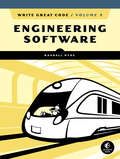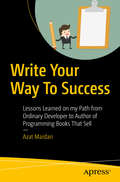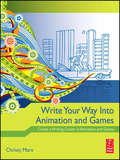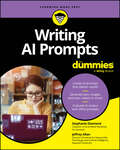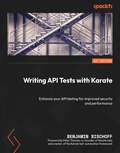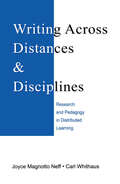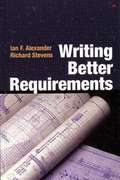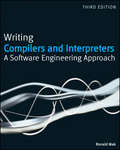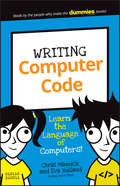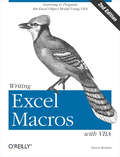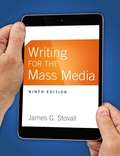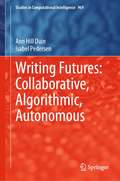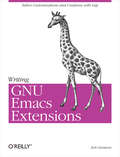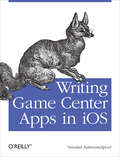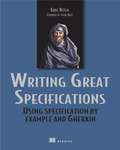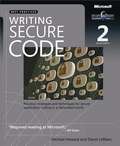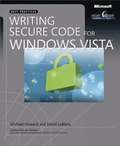- Table View
- List View
Write Great Code, Volume 3: Engineering Software
by Randall HydeEngineering Software, the third volume in the landmark Write Great Code series by Randall Hyde, helps you create readable and maintainable code that will generate awe from fellow programmers.The field of software engineering may value team productivity over individual growth, but legendary computer scientist Randall Hyde wants to make promising programmers into masters of their craft. To that end, Engineering Software--the latest volume in Hyde's highly regarded Write Great Code series--offers his signature in-depth coverage of everything from development methodologies and strategic productivity to object-oriented design requirements and system documentation.You'll learn: • Why following the software craftsmanship model can lead you to do your best work • How to utilize traceability to enforce consistency within your documentation • The steps for creating your own UML requirements with use-case analysis • How to leverage the IEEE documentation standards to create better softwareThis advanced apprenticeship in the skills, attitudes, and ethics of quality software development reveals the right way to apply engineering principles to programming. Hyde will teach you the rules, and show you when to break them. Along the way, he offers illuminating insights into best practices while empowering you to invent new ones.Brimming with resources and packed with examples, Engineering Software is your go-to guide for writing code that will set you apart from your peers.
Write Powerful Rust Macros
by Sam Van OvermeireAn example-driven, step-by-step guide to success with Rust macros.In Write Powerful Rust Macros you&’ll learn how to use these amazing metaprogramming tools to push Rust to its full potential. This hands-on guide takes you from the absolute basics to advanced macro techniques, exploring Rust macros through interesting and engaging examples. Inside Write Powerful Rust Macros you&’ll discover: Writing declarative macros Procedural macros Reading and debugging macro code Improving the type system with newtypes and zero-sized types How common Rust libraries use macros Write Powerful Rust Macros teaches you how to write, test, debug, and publish macros for Rust. It&’s perfect for Rust practitioners who want to master this powerful development technique. Build your knowledge chapter-by-chapter. You&’ll start with declarative macros before diving into the real power: procedural macros that can generate code, augment data structures, and even create domain-specific languages. About the technology Macros are one of Rust&’s most important and powerful tools. Although notoriously challenging, this metaprogramming technique has a big payoff. Using macros to generate new Rust code at compile-time can save you hours of tedious coding with negligible runtime performance impact. This book shows you exactly how to master this Rust superpower. About the book Write Powerful Rust Macros opens up the world of macros to intermediate Rust programmers. You&’ll start with declarative macros to get the basics under your belt. Then, you&’ll advance to procedural macros as you automatically generate a builder, learn to create your own domain-specific languages, and more. As you go, you&’ll develop practical skills like testing macros, integrating macros with crates, and even sharing your macros with other developers. What's inside How Rust libraries use macros Reading and debugging macro code newtypes and the type state pattern About the reader For intermediate Rust programmers. About the author Sam Van Overmeire is an experienced Rust developer and the author of multiple books, scientific articles and blog posts. The technical editor on this book was Andrew Lilley Brinker. Table of contents 1 Going meta 2 Declarative macros 3 A &“Hello, World&” procedural macro 4 Making fields public with attribute macros 5 Hiding information and creating mini-DSLs with function-like macros 6 Testing a builder macro 7 From panic to result: Error handling 8 Builder with attributes 9 Writing an infrastructure DSL 10 Macros and the outside world
Write Your Way To Success: Lessons Learned On My Path From Ordinary Developer To Writer Of Multiple Programming Books That Sell
by Azat MardanLearn how to make an impact in the web world. This short book shows you that the best way to become an expert and a thought leader is to thoroughly research a topic and then publish a book on it. The great thing about writing a book is that you don’t have to risk anything - all you need is a few hours of writing per week and in no time you can have your own book that you can sell, give away at conferences, and prominently feature on your resume. Since author Azat Mardan published his first book, several high profile tech companies have tried to recruit him and his experience is not an exception! Write Your Way To Success covers everything that he has learned through publishing – see how you can do the same!What You'll LearnCreate passive incomeReview the process of a ProgWriterExamine practical tips about publishing and marketingWho This Book Is ForAny experts (or wannabe experts) in technical topics, tools, frameworks for web development, applied computer science, dev ops and QA.
Write Your Way into Animation and Games: Create a Writing Career in Animation and Games
by Christy MarxLaunch your career in writing for video games or animation with the best tips, tricks, and tutorials from the Focal press catalog--all at your fingertips. Let our award-winning writers and game developers show you how to generate ideas and create compelling storylines, concepts, and narratives for your next project. Write Your Way Into Animation and Games provides invaluable information on getting into the game and animation industries. You will benefit from decades of insider experience about the fields of animation and games, with an emphasis on what you really need to know to start working as a writer. Navigate the business aspects, gain unique skills, and develop the craft of writing specifically for aniamtion and games. Learn from the cream of the crop who have shared their knowledge and experience in these key Focal Press guides: Digital Storytelling, Second Edition by Carolyn Handler Miller Animation Writing and Development by Jean Ann Wright Writing for Animation, Comics, and Games by Christy Marx Story and Simulations for Serious Games by Nick Iuppa and Terry Borst Writing for Multimedia and the Web, Third Edition by Timothy Garrand
Writing AI Prompts For Dummies
by Stephanie Diamond Jeffrey AllanLearn the art of writing effective AI prompts and break into an exciting new career field Unlock the full power of generative AI with Writing AI Prompts For Dummies, a comprehensive guide that will teach you how to confidentially write effective AI prompts. Whether it's text, images, or even videos and music you're aiming to create, this book provides the foundational knowledge and practical strategies needed to produce impressive results. Embark on a journey of discovery with Writing AI Prompts For Dummies and learn how to: Craft AI prompts that produce the most powerful results. Navigate the complexities of different AI platforms with ease. Generate a diverse range of content, from compelling narratives to stunning visuals. Refine AI-generated output to perfection and integrate that output effectively into your business or project. This resource is brimming with expert guidance and will help you write AI prompts that achieve your objectives. Whether you're a marketer, educator, artist, or entrepreneur, Writing AI Prompts For Dummies is your indispensable guide for leveraging AI to its fullest potential. Get ready to harness the power of artificial intelligence and spark a revolution in your creative and professional efforts.
Writing API Tests with Karate: Enhance your API testing for improved security and performance
by Peter Thomas Benjamin BischoffUnlock the full potential of Karate with this comprehensive guide to effortlessly setup, write, run, optimize, and report test resultsPurchase of the print or Kindle book includes a free PDF eBookKey FeaturesExplore the capabilities of the Karate framework for effective software testingLearn how to integrate Karate tests into projects and CI/CD pipelinesExplore lesser-known Karate modules such as Karate UI and Karate GatlingBook DescriptionSoftware in recent years is moving away from centralized systems and monoliths to smaller, scalable components that communicate with each other through APIs. Testing these communication interfaces is becoming increasingly important to ensure the security, performance, and extensibility of the software. A powerful tool to achieve safe and robust applications is Karate, an easy-to-use, and powerful software testing framework. In this book, you'll work with different modules of karate to get tailored solutions for modern test challenges. You'll be exploring interface testing, UI testing as well as performance testing. By the end of this book, you'll be able to use the Karate framework in your software development lifecycle to make your APIs and applications robust and trustworthy.What you will learnUnderstand the basic concepts of Karate and its functionalityIntegrate and use it effectively to solve your testing needsExtend Karate and customize its functionality for your use casesExplore different testing methods and their use casesRun your tests to check the software development lifecycleGet to know more about Karate's UI and performance test approachesWho this book is forThis book is for QA engineers and developers who are familiar with APIs and want to make them safer and more secure by applying automated tests with the help of a lightweight and modern framework - Karate.
Writing Across Distances and Disciplines: Research and Pedagogy in Distributed Learning
by Joyce Magnotto Neff Carl WhithausWriting Across Distances and Disciplines addresses questions that cross borders between onsite, hybrid, and distributed learning environments, between higher education and the workplace, and between distance education and composition pedagogy. This groundbreaking volume raises critical issues, clarifies key terms, reviews history and theory, analyzes current research, reconsiders pedagogy, explores specific applications of WAC and WID in distributed environments, and considers what business and education might teach one another about writing and learning. Exploring the intersection of writing across the curriculum, composition studies, and distance learning , it provides an in-depth look at issues of importance to students, faculty, and administrators regarding the technological future of writing and learning in higher education.
Writing Apache Modules with Perl and C
by Doug Maceachern Lincoln SteinThis guide to web programming shows how to extend the capabilities of the Apache web server. It explains the design of Apache, mod_perl, and the Apache API, then demonstrates how to use them to rewrite CGI scripts, filter HTML documents on the server-side, enhance server log functionality, convert file formats on the fly, and more.
Writing Better Requirements
by Richard Stevenson Ian F. AlexanderIf you are involved in the systems engineering process in any company, you will learn how to write requirements to get the system you want.
Writing Community Change: Designing Technologies for Citizen Action
by Jeffrey T. GrabillA book on writing for community change by use of information technology.
Writing Compilers and Interpreters
by Ronald MakLong-awaited revision to a unique guide that covers both compilers and interpreters Revised, updated, and now focusing on Java instead of C++, this long-awaited, latest edition of this popular book teaches programmers and software engineering students how to write compilers and interpreters using Java. You?ll write compilers and interpreters as case studies, generating general assembly code for a Java Virtual Machine that takes advantage of the Java Collections Framework to shorten and simplify the code. In addition, coverage includes Java Collections Framework, UML modeling, object-oriented programming with design patterns, working with XML intermediate code, and more.
Writing Computer Code: Learn the Language of Computers!
by Chris Minnick Eva HollandA technology book for kids! Learning how to code can be like learning a foreign language.This book serves as an excellent guide to help you start writing in the odd-looking languages that make the web work. Follow simple steps as you work with real code to build your own web robots. Create your robot--write code that builds your robot's body and structure Give your bot some style--add code lines that customize your robot's color and shape Get your robot moving--finish off your robot with code that teaches it how to dance Technology Requirements: Hardware - PC or tablet with Internet connection running Windows 7 or higher or Mac with Internet connection running Mac OS X 10.7 or higher Software - Web browser to access JSFiddle.net: Google ChromeTM, Mozilla Firefox, Apple Safari, Microsoft Edge, or Microsoft Internet Explorer version 9.0 or higher
Writing Effective E-Mail: Improving Your Electronic Communication
by Nancy Flynn Tom FlynnThe revised edition of Writing Effective E-Mail includes an added emphasis on how to avoid workplace disasters such as lost sales, customer service nightmares--and in the worst cases--lawsuits and financial losses, triggered by careless or poorly written e-mails. This book will also guide you in writing a comprehensive and effective e-mail policy for your organization.
Writing Essentials: A Norton Pocket Guide
by Dawn Rodriguez Myron C. TumanWriting Essentials combines the essentials of grammar, punctuation, mechanics, and documentation with practical suggestions for writing online.<P> From online prewriting, drafting, group workshopping, revising, and editing, to database searching, navigating the Internet, documenting online sources, and designing documents, Writing Essentials offers practical, hands-on advice for using computers throughout the writing process.
Writing Excel Macros with VBA, 2nd Edition
by Steven RomanNewly updated for Excel 2002, Writing Excel Macros with VBA, 2nd Edition provides Excel power-users, as well as programmers who are unfamiliar with the Excel object model, with a solid introduction to writing Visual Basic for Applications (VBA) macros and programs for Excel. In particular, the book focuses on: * The Visual Basic Editor and the Excel VBA programming environment. Excel features a complete, state-of-the-art integrated development environment for writing, running, testing, and debugging VBA macros. The VBA programming language, the same programming language used by the other applications in Microsoft Office XP and 2000, as well as by the retail editions of Visual Basic 6.0. The Excel object model, including new objects and new members of existing objects in Excel 2002. Excel exposes nearly all of its functionality through its object model, which is the means by which Excel can be controlled programmatically using VBA. While the Excel object model, with 192 objects, is the second largest among the Office applications, you need to be familiar with only a handful of objects to write effective macros. Writing Excel Macros focuses on these essential objects, but includes a discussion of many more objects as well. Writing Excel Macros with VBA, 2nd Edition is written in a terse, no-nonsense manner that is characteristic of Steven Roman's straightforward, practical approach. Instead of a slow-paced tutorial with a lot of handholding, Roman offers the essential information about Excel VBA that you must master to write macros effectively. This tutorial is reinforced by interesting and useful examples that solve common problems you're sure to have encountered. Writing Excel Macros with VBA, 2nd Edition is the book you need to delve into the basics of Excel VBA programming, enabling you to increase your power and productivity.
Writing Excel Macros with VBA: Learning to Program the Excel Object Model Using VBA
by Steven RomanNewly updated for Excel 2002, Writing Excel Macros with VBA, 2nd Edition provides Excel power-users, as well as programmers who are unfamiliar with the Excel object model, with a solid introduction to writing Visual Basic for Applications (VBA) macros and programs for Excel. In particular, the book focuses on:The Visual Basic Editor and the Excel VBA programming environment. Excel features a complete, state-of-the-art integrated development environment for writing, running, testing, and debugging VBA macros.The VBA programming language, the same programming language used by the other applications in Microsoft Office XP and 2000, as well as by the retail editions of Visual Basic 6.0. The Excel object model, including new objects and new members of existing objects in Excel 2002. Excel exposes nearly all of its functionality through its object model, which is the means by which Excel can be controlled programmatically using VBA. While the Excel object model, with 192 objects, is the second largest among the Office applications, you need to be familiar with only a handful of objects to write effective macros. Writing Excel Macros focuses on these essential objects, but includes a discussion of many more objects as well.Writing Excel Macros with VBA, 2nd Edition is written in a terse, no-nonsense manner that is characteristic of Steven Roman's straightforward, practical approach. Instead of a slow-paced tutorial with a lot of handholding, Roman offers the essential information about Excel VBA that you must master to write macros effectively. This tutorial is reinforced by interesting and useful examples that solve common problems you're sure to have encountered.Writing Excel Macros with VBA, 2nd Edition is the book you need to delve into the basics of Excel VBA programming, enabling you to increase your power and productivity.
Writing For The Mass Media (Ninth Edition)
by James G. StovallA clear and effective introduction to media writing Writing for the Mass Media offers clear writing, simple organization, abundant exercises, and precise examples that give students information about media writing and opportunities to develop their skills as professional writers. With a focus on a converged style of media writing, and converting that style into real work, this ninth edition maintains its classic and effective text/workbook format while staying ahead of the curve and preparing students for their future careers. MyCommunicationLab is an integral part of the Stovall program. MediaShare allows students to post speeches and share them with classmates and instructors. Interactive videos provide students with the opportunity to watch and evaluate sample speeches. Online self-assessments and pre- and post-tests help students assess their comfort level with public speaking and their knowledge of the material.
Writing Futures: Collaborative, Algorithmic, Autonomous (Studies in Computational Intelligence #969)
by Ann Hill Duin Isabel PedersenThis book is useful to understand and write alongside non-human agents, examine the impact of algorithms and AI on writing, and accommodate relationships with autonomous agents. This ground-breaking future-driven framework prepares scholars and practitioners to investigate and plan for the social, digital literacy, and civic implications arising from emerging technologies. This book prepares researchers, students, practitioners, and citizens to work with AI writers, virtual humans, and social robots. This book explores prompts to envision how fields and professions will change. The book’s unique integration with Fabric of Digital Life, a database and structured content repository for conducting social and cultural analysis of emerging technologies, provides concrete examples throughout. Readers gain imperative direction for collaborative, algorithmic, and autonomous writing futures.
Writing GNU Emacs Extensions: Editor Customizations and Creations with Lisp
by Bob GlicksteinYes, it is possible to be all things to all people, if you're talking about the Emacs editor. As a user, you can make any kind of customization you want, from choosing the keystrokes that invoke your favorite commands to creating a whole new work environment that looks like nothing ever developed before. It's all in Emacs Lisp -- and in this short but fast-paced book.GNU Emacs is more than an editor; it's a programming environment, a communications package, and many other things. To provide such a broad range of functions, it offers a full version of the Lisp programming language -- something much more powerful than the little macro languages provided in other editors (including older versions of Emacs). GNU Emacs is a framework in which you can create whole new kinds of editors or just alter aspects of the many functions it already provides.In this book, Bob Glickstein delves deep into the features that permit far-reaching Emacs customizations. He teaches you the Lisp language and discusses Emacs topics (such as syntax tables and macro templates) in easy-to-digest portions. Examples progress in complexity from simple customizations to extensive major modes.You will learn how to write interactive commands, use hooks and advice, perform error recovery, manipulate windows, buffers, and keymaps, exploit and alter Emacs's main loop, and more. Each topic is explored through realistic examples and a series of successive refinements that illustrate not only the Emacs Lisp language, but the development process as well, making learning pleasant and natural.
Writing Game Center Apps in iOS: Bringing Your Players Into the Game
by Vandad NahavandipoorNow that Apple has introduced the GameKit framework to its iOS SDK, you can integrate Game Center features directly into your iPhone and iPad apps. This concise cookbook shows you how it's done, with 18 targeted recipes for adding leaderboards, user authentication, achievements, multiplayer games, and many other features.How do you display players' scores and achievements? How do you create Game Center accounts and add friends? Each recipe in this book includes a simple code solution you can put to work immediately, along with a detailed discussion that offers insight into why and how the recipe works.Recipes include techniques to:Set up Game Center for an iOS AppUse block objects and Grand Central Dispatch to write Game Center appsAuthenticate a local player in Game CenterUse iTunes Connect to create leaderboards and achievementsRetrieve leaderboard and achievement information programmaticallyHandle players' state changes in multiplayer games
Writing Great Specifications: Using Specification by Example and Gherkin
by Kamil NiciejaSummaryWriting Great Specifications is an example-rich tutorial that teaches you how to write good Gherkin specification documents that take advantage of the benefits of specification by example. Foreword written by Gojko Adzic.Purchase of the print book includes a free eBook in PDF, Kindle, and ePub formats from Manning Publications.About the TechnologyThe clearest way to communicate a software specification is to provide examples of how it should work. Turning these story-based descriptions into a well-organized dev plan is another matter. Gherkin is a human-friendly, jargon-free language for documenting a suite of examples as an executable specification. It fosters efficient collaboration between business and dev teams, and it's an excellent foundation for the specification by example (SBE) process.About the BookWriting Great Specifications teaches you how to capture executable software designs in Gherkin following the SBE method. Written for both developers and non-technical team members, this practical book starts with collecting individual feature stories and organizing them into a full, testable spec. You'll learn to choose the best scenarios, write them in a way that anyone can understand, and ensure they can be easily updated by anyone.management. What's InsideReading and writing GherkinDesigning story-based test casesTeam CollaborationManaging a suite of Gherkin documentsAbout the ReaderPrimarily written for developers and architects, this book is accessible to any member of a software design team.About the AuthorKamil Nicieja is a seasoned engineer, architect, and project manager with deep expertise in Gherkin and SBE.Table of contentsIntroduction to specification by example and Gherkin PART 1 - WRITING EXECUTABLE SPECIFICATIONS WITH EXAMPLESThe specification layer and the automation layer Mastering the Given-When-Then template The basics of scenario outlines Choosing examples for scenario outlines The life cycle of executable specifications Living documentation PART 2 - MANAGING SPECIFICATION SUITES Organizing scenarios into a specification suite Refactoring features into abilities and business needs Building a domain-driven specification suite Managing large projects with bounded contexts
Writing In-House Medical Device Software in Compliance with EU, UK, and US Regulations
by Philip S. Cosgriff Matthew J. MemmottThis book is a comprehensive guide to producing medical software for routine clinical use. It is a practical guidebook for medical professionals developing software to ensure compliance with medical device regulations for software products intended to be sold commercially, shared with healthcare colleagues in other hospitals, or simply used in-house.It compares requirements and latest regulations in different global territories, including the most recent EU regulations as well as UK and US regulations.This book is a valuable resource for practising clinical scientists producing medical software in-house, in addition to other medical staff writing small apps for clinical use, clinical scientist trainees, and software engineers considering a move into healthcare. The academic level is post-graduate, as readers will require a basic knowledge of software engineering principles and practice.Key Features: Up to date with the latest regulations in the UK, the EU, and the US Useful for those producing medical software for routine clinical use Contains best practice
Writing Secure Code
by Michael Howard David LeblancKeep black-hat hackers at bay with the tips and techniques in this entertaining, eye-opening book! Developers will learn how to padlock their applications throughout the entire development process--from designing secure applications to writing robust code that can withstand repeated attacks to testing applications for security flaws. Easily digested chapters reveal proven principles, strategies, and coding techniques. The authors--two battle-scarred veterans who have solved some of the industry's toughest security problems--provide sample code in several languages. This edition includes updated information about threat modeling, designing a security process, international issues, file-system issues, adding privacy to applications, and performing security code reviews. It also includes enhanced coverage of buffer overruns, Microsoft® .NET security, and Microsoft ActiveX® development, plus practical checklists for developers, testers, and program managers.
Writing Secure Code for Windows Vista®
by Michael Howard David LeblancGet the definitive guide to writing more-secure code for Windows Vista--from the authors of the award-winning Writing Secure Code, Michael Howard and David LeBlanc. This reference is ideal for developers who understand the fundamentals of Windows programming and APIs. It complements Writing Secure Code, examining the delta between Windows XP and Windows Vista security. You get first-hand insights into design decisions, lessons learned from Windows Vista development, and practical advice for solving real-world security issues. Discover how to: Develop applications to run without administrator privileges Apply best practices for using integrity controls Help protect your applications with ASLR, NX, and SafeSEH Evaluate authentication, authorization, and cryptography enhancements in Windows Vista Write services that restrict privileges and tokens--and sidestep common problems Learn how Windows Internet Explorer 7 defenses and new security features affect your development efforts PLUS--Get Microsoft Visual C#, Visual C++, and C code samples on the Web
Writing Space: Computers, Hypertext and the Remediation of Print (2nd edition)
by Jay David BolterWhen Bolter (Georgia Institute of Technology) finished the first edition in the early 1990s, the World Wide Web was only a couple years old and was still used primarily by research centers and universities. Changes in the technology, the use of it, and the perception of it has convinced him to shift the focus of the second edition to show how hypertext and other forms of electronic writing refashion the forms and genres of print.
